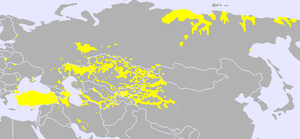الخاقانية التوركية الغربية
Onoq ("السهام العشر") الخاقانية التوركية الغربية | |||||||||||||||
|---|---|---|---|---|---|---|---|---|---|---|---|---|---|---|---|
| 581–659 | |||||||||||||||
 أقصى اتساع للخاقانية التوركية الغربية بعد معركة بخارى | |||||||||||||||
| المكانة | خاقانية | ||||||||||||||
| العاصمة | Navekat (العاصمة الصيفية) Suyab (العاصمة الرئيسية) | ||||||||||||||
| اللغات الشائعة | التوركية | ||||||||||||||
| الدين | Tengrism | ||||||||||||||
| خان | |||||||||||||||
| الحقبة التاريخية | Early Middle Ages | ||||||||||||||
• Turkic Khaganate founded | 552 | ||||||||||||||
• Göktürk civil war, Western Turkic dynasty founded | 581 | ||||||||||||||
• Conquest by Tang dynasty | 659 | ||||||||||||||
• Second Turkic Khaganate established | c. 680 | ||||||||||||||
| Area | |||||||||||||||
| 630[1] | 3،500،000 km2 (1،400،000 sq mi) | ||||||||||||||
| |||||||||||||||
| Today part of | |||||||||||||||
جزء من سلسلة عن |
|---|
| تاريخ شينجيانگ |
 |
الخاقانية التوركية الغربية أو Onoq Khaganate (الصينية: 西突厥; پنين: Xi tūjué) was a Turkic khaganate formed as a result of the wars in the beginning of the 7th century (593 – 603 AD) after the split of the Göktürk Khaganate (founded in the 6th century in منغوليا by the Ashina clan) into the Western khaganate and the الخاقانية التوركية الشرقية.
في أوج عزها، ضمت الخاقانية التوركية الغربية الأراضي ما هو الآن قزخستان وقيرغيزستان وطاجيكستان وتركمنستان وأوزبكستان.
The ruling elite of the Western Turkic Khaganate were the Onogurs – an oğuz (literally "arrow"), a subdivision of the Turkic tribes. The name of the Onugurs is derived from the proto-Turkic Onoq ("ten arrows").
Initially, the Western khaganate sought friendly relations with the Eastern Roman Empire, in order to expand their territory at the expense of their mutual enemy, the Sassanid Persian Empire.[5]
الخاقانيتان الغربية والشرقية اتحدتا مرة أخرى ليصبحا الخاقانية التوركية في 682.
انظر أيضاً
- الخاقانية التوركية الشرقية
- Onogurs
- Utigurs
- Bulgars
- تاريخ تركيا
- Ishbara Tolis (Dielishi Qaghan )
- Old Great Bulgaria
- Göktürks
- Oghuz Turks
- Turks in the Tang military
- Turkic interregnum
- Turkic peoples
- Timeline of Turks (500-1300)
- List of Turkic dynasties and countries
الهامش
- ^ Taagepera, Rein (1979). "Size and Duration of Empires: Growth-Decline Curves, 600 B.C. to 600 A.D." Social Science History. 3 (3/4): 129. doi:10.2307/1170959. Retrieved 16 September 2016.
- ^ Marshall Cavendish Corporation (2006). Peoples of Western Asia. p. 364.
{{cite book}}: External link in|ref= - ^ Bosworth, Clifford Edmund (2007). Historic Cities of the Islamic World. p. 280.
{{cite book}}: External link in|ref= - ^ Borrero, Mauricio (2009). Russia: A Reference Guide from the Renaissance to the Present. p. 162.
{{cite book}}: External link in|ref= - ^ Twitchett, David. The Cambridge History of China. Cambridge University Press, 1979. ISBN 0-521-21446-7. Page 223.

